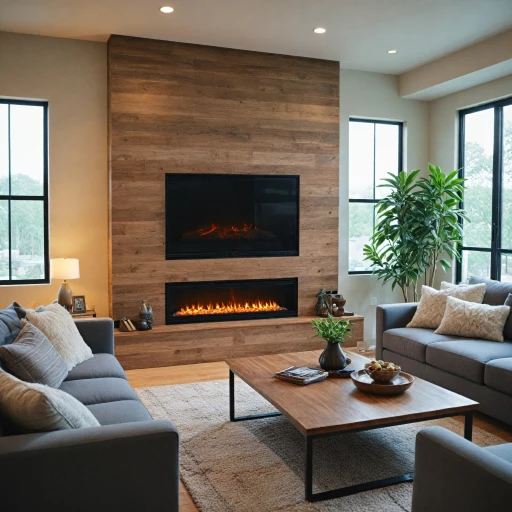
Understanding Liquid Propane Fireplace Inserts
Delving into the World of Liquid Propane Fireplace Inserts
Liquid propane fireplace inserts are gaining attention for their numerous benefits, particularly in providing efficient heating solutions. These inserts are designed to fit directly into existing fireplaces, transforming an old wood burning setup into a high-efficiency propane burning fireplace. The process is seamless, offering an impressive combination of traditional warmth and modern convenience. When considering a fireplace insert, it's essential to understand the difference between vented and vent free models. A vent free setup eliminates the need for a chimney, thus allowing flexible placement within your home. Conversely, vented inserts require a working chimney, mimicking the authentic look of a traditional fire with the use of gas logs. Prospective buyers should note the critical role of BTU (British Thermal Units) ratings when selecting an insert. Higher BTUs mean more heat, effectively warming larger spaces. So, if you’re looking to heat a substantial area, a model with high BTU output might be preferable. Lastly, control models for these units vary, providing different levels of interaction, from basic thermostatic control to advanced remote-operated systems. Armed with the right features, a liquid propane fireplace insert can easily blend into any home décor, offering both aesthetic charm and practical function. For more insights on how to enhance your home with efficient inserts, featuring blowers among other options, check out our enriched resource here. By doing so, you can explore how these versatile and stylish options can redefine your living space.Advantages of Using Liquid Propane Fireplace Inserts
Why You Might Want to Consider These Fireplace Inserts
When it comes to creating a warm and inviting atmosphere, liquid propane fireplace inserts bring an undeniable charm and efficiency to any living space. They easily match the heat output and elegance of their traditional counterparts without the fuss of chopping wood or cleaning up charred residues. A propane fireplace insert turns the idea of warmth into a convenient reality with the flair of flickering gas flames on realistic logs.
Here’s why these inserts top the list for homeowners:
- High Heat Output: Whether you're dealing with a chill that’s crept into the room or the bitter cold of winter, these inserts pack a punch with their impressive BTU ratings. They’re designed to quickly heat a space, drawing from a propane tank to provide an adjustable and consistent warmth.
- Convenience and Control: Forget the chaos of wood burning. A simple flick of a switch or a stat control can start or stop the fire. Models are available with a variety of control options, bringing all the ease and convenience you could want.
- Vent-Free Models: Enjoy the flexibility of inserting some models into spaces without worrying about building or maintaining a dedicated vent system.
- Cost Efficiency: Propane is often a more cost-effective fuel option compared to some other gas options, offering significant savings in certain regions.
If you're curious about enhancing your home with efficient options, these propane inserts might just fit the bill. Their dual fuel capabilities also allow some models to operate with natural gas, providing even greater versatility.
Installation Process and Requirements
Getting Set Up: How to Install a Liquid Propane Fireplace Insert
When deciding to install a liquid propane fireplace insert, knowing the basic steps and requirements will ensure you're prepared for a smooth and safe installation. Before we dive into details, it's essential to check if a vent-free model or a model that requires a venting system suits your home, as each comes with unique requirements. First, make sure your chosen space can accommodate the insert:- Measure Your Space: Ensure you know the dimensions where you plan to install the fireplace insert. It's crucial to match the dimensions provided by your chosen model to the space available.
- Check For Venting: Depending on whether you're using a vent-free or vented system, you’ll either need to establish proper ventilation or ensure your space can support a vent-free setup.
- Secure A Propane Tank: You’ll need to connect the insert to an existing natural gas line or a dedicated propane tank. Be sure to use a qualified technician for gas line setups.
- Gas Line Installation: It’s wise to enlist a professional for this task to avoid any hazards associated with fuel fireplace setups. Safety first!
- Select The Right Gas Logs: Choosing the proper gas log set will influence both function and aesthetic. Opt for a set that best fits the style of your space while ensuring compatibility with your insert.
- Control Model Options: Consider if you’d like a basic unit or something with more functionality, like the Duluth Forge stat control feature for easier flame and heat adjustments.
Maintenance Tips for Longevity
Keeping Your Liquid Propane Fireplace Insert in Top Shape
Owning a propane fireplace insert can be a delightful way to add warmth and ambiance to your space. To ensure your fireplace remains as effective as it was on day one, a little maintenance is necessary. Here are some tips to help your insert function smoothly and safely for years to come:- Regular Inspection: Just like you wouldn’t drive your car for years without a check-up, your propane insert deserves the same love. Regular inspections not only help in catching potential issues but also ensure everything is operating safely. Check for any gas leaks or unusual odors.
- Clean the Glass: Over time, soot and residue from the gas logs can obscure the view of those beautiful, dancing flames. Use a non-abrasive cleaner to keep the glass spotless. This will also allow for clear enjoyment of your burning fire.
- Gas Line and Tanks: The propane gas tank and lines are the lifeblood of fuel fireplaces. Make sure they’re free from obstructions, and the connections remain tight. A leaky gas connection can pose significant safety risks.
- Inspect the Pilot Light: If your insert uses a pilot light, make sure it's consistently operational. A malfunctioning pilot can mean your fireplace insert won’t start when you want that cozy feel.
- Vent Maintenance: If your model isn’t vent free, then ensuring the vent is clean and unblocked is crucial. This helps in the efficient release of combustion by-products, ensuring clean air in your living space.
- Replace Parts as Needed: If you notice any wear and tear on the logs or any part of the insert, it might be time for a replacement. Keeping a keen eye on the components can prevent larger problems later.
Comparing Liquid Propane and Electric Fireplaces
Electric vs. Liquid Propane Fireplace: A Warm Comparison
When choosing between a liquid propane fireplace insert and its electric counterpart, it’s essential to consider what best suits your home and lifestyle. Here’s how the two stack up:- Heat Output: Propane fireplace inserts, renowned for their high BTU ratings, can efficiently heat larger spaces with their intense gas logs and burning capabilities. Electric models, while often more suitable for smaller areas, offer consistent warmth without the need for a vent or gas tank.
- Installation Flexibility: A propane fireplace insert necessitates a connection to a gas line or propane tank, sometimes requiring extensive setup. Electric fireplaces offer more installation freedom—some models even allow vent-free setups, making them versatile for different spaces.
- Maintenance and Operation: Propane inserts require regular maintenance of gas inserts, logs, and vents to ensure safety and efficiency. Electric fireplaces are comparatively effortless to maintain, often needing only periodic dusting and checks of electrical components.
- Environmental Considerations: Natural gas and propane gas fireplaces release emissions, although they are cleaner than wood burning fireplaces. Electric models are environmentally friendly since they do not emit gasses, though they rely on electricity sources that may be fossil fuel-based.
- Price and Cost of Operation: While initial costs can vary, running an electric fireplace is generally more cost-effective than a propane model due to the price fluctuations of propane fuel.
Safety Considerations and Best Practices
Safety Measures You Shouldn't Overlook
When it comes to fireplace inserts, safety should always be top-of-mind. Whether you choose a liquid propane model or an electric option, knowing the right precautions can keep your indoor environment safe and cozy. Here's a look at some safety considerations you need to keep handy.- Proper Ventilation: Ventilation is crucial for a gas fireplace insert, especially with vent-free propane models. Without a vent, the byproducts of burning can accumulate, posing a risk to air quality. Make sure your space is well-ventilated or opt for models with a direct vent to expel gases outside.
- Tank Inspection: Regular inspections of your propane gas tank are essential. Monitor for leaks or damage, ensuring it's stored securely. Remember, a poorly maintained tank is a recipe for disaster.
- Heat Control: Heat control is often overlooked. With stat control models, you have more precision in managing BTU output, helping you prevent overheating inside your living space. Safe heat levels can avoid damage to your home and furnishings.
- Fireplace Maintenance: Regular cleaning and maintenance can prevent risks associated with gas logs and air blockage. A buildup of debris can affect the efficiency and safety of your fireplace.
- Carbon Monoxide Detectors: Installing carbon monoxide detectors in rooms with gas fireplaces is a must. A dual fuel setup can offer peace of mind if you often switch between natural gas and propane.
- Safety Screens: Use safety screens to prevent contact with the fire, log, or inserts gas setups. This is especially vital if you have young children or pets around. Safety screens act as a barrier, reducing burn risks considerably.












